主題詳細資料
什麼是節點分析?
節點分析是一種計算電路中,元件之間連接點 (稱為節點) 電壓的方法。它是電路分析的基礎部分,包含從連接獨立元件的簡單有線電路,到複雜的半導體積體電路 (IC)。
在簡單的節點分析中,元件之間的每個連接 (走線或電線) 都稱為節點。克希荷夫定律與歐姆定律用於編寫導引到每個節點的每個導電路徑之電阻、電流和電壓相關的方程式。接著,就可以手動或使用線性代數來解出每個節點電壓降的方程式系統。對於較大的問題,軟體通常是以 SPICE 電路模擬器的形式存在,用於進行節點分析。
節點分析的基本定律
節點分析方法以三項基本原則為基礎:
1.克希荷夫電流定律 (KCL)
所有進入和退出節點電流的代數總和必須等於零。
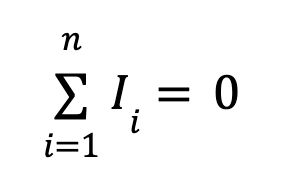
其中 I 為電流,而 n 是指送進節點的分支數量。
2.克希荷夫電壓定律 (KVL)
迴圈中所有潛在差異 (電壓) 的代數總和必須等於零。
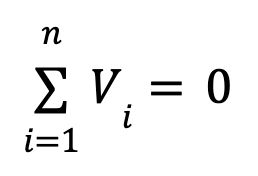
其中 V 為電壓,而 n 是在迴路周圍測量電壓的位置數。
3.歐姆定律
通過導體的電流 (I) 等於導體兩端的電壓 (V) 除以導體的電阻 (R)。
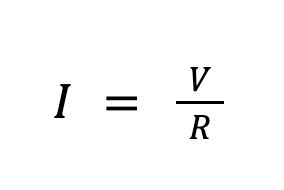
節點分析術語
對於節點分析,會使用電路圖來表示下列項目的網路:
參考節點:已知電壓電路中的節點。這通常是接地節點,且電壓設為 0。
非參考節點:未知電壓的任何節點
電壓源:電路中的元件,其電位由已知電壓改變
電流源:已知電流的元件
超節點:當電壓來源在任一側有兩種未知電壓時,可將其轉換為超節點,其中兩個節點的電流會結合為單一方程式。然後可寫入超節點電壓電流關係的新方程式。
元件:電壓與電流間具有已知關係的電子裝置。對於電阻器而言,這種關係是以電阻為基礎。它通常以導納,或電阻反向表示。電容器的關係則取決於電容以及隨時間變化電壓之間的關係。
修正節點分析:對於較複雜的電路,簡易的節點分析可能不足以找出所有未知電壓。如元件的電流-電壓關係比歐姆定律更為複雜,則會執行修正節點分析。
網目分析法:若不知道電流,克希荷夫電壓定律則用於所謂的網目分析,以找出未知的分支電流。
為何節點分析很重要
電子電路是設計來傳送電流以提供電力和訊號。設計電路的工程師需要知道他們定義的電子設備能如預期般運作。執行節點分析,以計算電路每一部分的節點電壓和電流。一旦知道這些基本值,就能進行更複雜的分析,以瞭解訊號完整性、加熱和整體功率效能。
對於 PCB 層級的設計,可使用節點分析來瞭解電路板拓撲的衝擊、不同元件的影響,以及跨接接地面、走線和孔位等導電路徑的整體配電。
對於各種微晶片而言,瞭解功率損失變得更加重要。由於節點數量龐大,因此節點方程式的數目可能會變得相當龐大。只能透過電路分析來瞭解並確認電流、電壓和功率的分佈。
計算電壓降是節點分析的另一種常見用途,尤其是現今複雜的半導體產品。任何時間點的節點間電位降會產生熱能,並在其他地方失去所需功率。即使是最複雜的半導體,節點分析工具也能用於電路中因不必要或集中電壓降而造成的任何缺陷。
晶片設計人員可以運用這些工具,不只找出問題,還讓假設性研究能最佳化電力與效能。適用於數位與 3D IC 的 Ansys RedHawk-SC™ 功率整合式簽核平台等工具,在大型 HPC 雲端平台上運行,以支援最新的半導體架構中,具備數百萬個元件的大型電路。由於這是一種受到信賴的方法,因此許多晶圓代工都會認證 RedHawk-SC 軟體用於簽核。
用於執行節點分析的步驟
無論是在軟體中手動或自動完成,節點分析都遵循以下程序:
1.定義節點
擷取電路 (節點) 中所有連接的導電段。如以手動求解,請繪製電路並編號節點。若使用軟體,則從配置圖中以程式設計方式建立所有節點及其與元件連接的清單。
2.選擇接地節點
選擇一節點作為參考節點,並將其電壓定義為接地電壓。這會將系統中的未知數量減少一次。如果您有 n 個節點,則需要求解 n-1 個方程式。
3.建立變數
若是每個非參照節點的電壓未知,請指派變數以表示該節點的電壓。具有已知電壓的節點不需要變數。
4.構建節點方程式
逐一確認每個具有未知電壓的節點,並為該節點寫入 KCL 方程式。這包括將計算得出的節點各邊段分支電流相加,並將總和設為零。如果電流源位於節點之間,兩個節點之間的電流可能為已知值。這是節點之間的電壓差除以節點之間的電阻,也可能是電容器的電壓變化和電容之間的關係。其他元件可能有更複雜的方程式。
5.將節點合併為超節點
將連接兩種未知電壓的任何電壓源,與具有一個方程式的超節點結合。
6.組裝與求解
除非電路夠小足以手動求解,聯立方程式的系統可以重新排列成由 n-1 欄和列組成的方形矩陣。線性代數數值法可用來求解未知電壓。
節點分析的一些簡單範例
以下為能更佳說明此程序的簡單範例。下圖為具有一個電流源、一個 10 伏特的電壓源,以及兩個電阻器的電路。電壓 V1 不明。
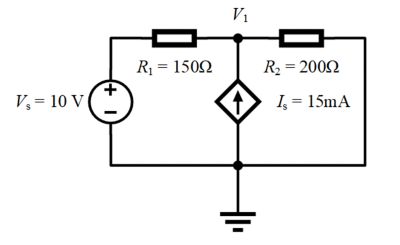
- V1 是唯一未知的電壓。另一個節點連接到地面,將成為我們的參考點。
- 節點 V1 有三個分支電流:
- 通過電阻器 R1 的電流:(V1 - Vs)/R1
- 通過電阻器 R2 的電流:(V1 - 0)/R2
- 通過電流源 Is 的電流:- Is
- 根據克希荷夫電流定律,我們將其加總並設為 0:

4.以 V1 的條件重寫:

現在,讓我們使用節點分析法來查看連接至兩個未知電壓的電壓源電路。
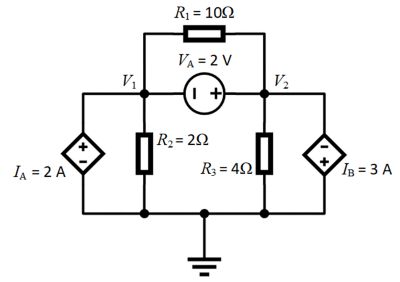
- V1 和V 2 有未知的節點電壓。另一個節點連接到地面,且將成為我們設為 0 伏特的參考節點。此外,VA 介於 V1 和 V2 之間,因此是超節點。
- 節點 V1 有三個分支電流:
- 通過電阻器 R1 的電流:(V1 -V 2)/R1
- 通過電阻器 R2 的電流:(V1 - 0)/R2
- 通過電流源 IA 的電流:- IA 或 2 安培
- 節點 V2 有四個分支電流:
- 通過電阻器 R1 的電流:(V2 - V1)/R1
- 通過電阻器 R2 的電流:(V2 - 0)/R3
- 通過電流源 Ib的電流:Ib 或 2 安培
- VA 的超節點方程式:V2 = V1 + VA
- 根據克希荷夫電流定律,我們將節點 1 的電流流量加總,並將其設為 0:

5.以 V1 的條件重寫:
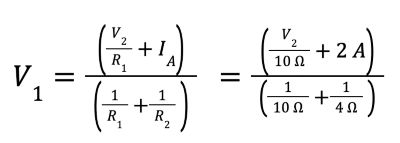
6.根據克希荷夫電流定律,我們將節點 2 的電流流量加總,並將其設為 0:

7.以 V2 的條件重寫。
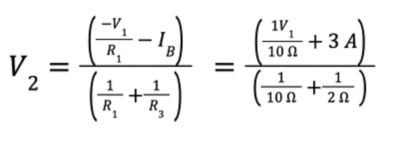
8.使用 V2 的超節點方程式並求解其他兩個方程式,我們得到 V1 = -7.33 V 以及 V2 = -5.33 V
開始使用複雜電力系統的節點分析
節點分析通常為 SPICE 求解器的形式,是說明任何電路行為特徵的基本步驟。從試驗電路板上的簡單電路,到具有數百萬電晶體的業界最新半導體,工程師需要使用 Ansys Totem™ 功率整合式平台等工具,不僅僅用於電壓計算,也要使用這些資訊來瞭解功率雜訊並達成類比混合訊號設計的可靠性簽核。
Ansys Twin Builder® 軟體提供完整的節點分析求解器,可與其他的降階工具搭配使用。有了它,您就可以在單一介面中分析電路及其連接在產品中的項目。
以下有幾項建議,可讓複雜電力系統應用節點分析更有效率且成功:
- 建構節點分析模型之前,請先瞭解您設計中的所有電路元件,包括其電路屬性。
- 請確保您對參考節點的假設正確:它們確實接地,且電壓不得浮動。
- 請確保您使用的工具能夠順暢讀取 ECAD 資料,且需要最少使用者輸入來建構電路呈現。
- 花點時間瞭解節點分析的基本知識。請花點時間進行教學課程,瞭解與您需要分析的元件類型所相關的簡單電路分析。
- 使用不僅有節點分析的軟體工具。使用將特定電路的節點分析視為進階模擬起點的解決方案。
相關資源
讓我們開始吧
如果您面臨工程挑戰,我們的團隊將隨時為您提供協助。憑藉豐富的經驗和對創新的承諾,我們邀請您與我們聯絡。讓我們共同合作,將您的工程障礙轉化為成長和成功的機會。立即與我們聯絡,開始對話。